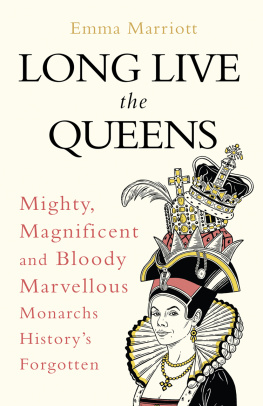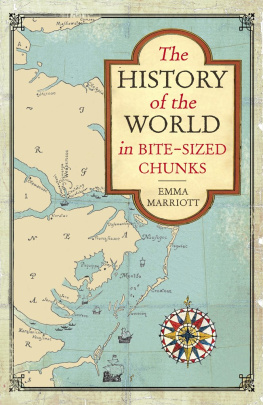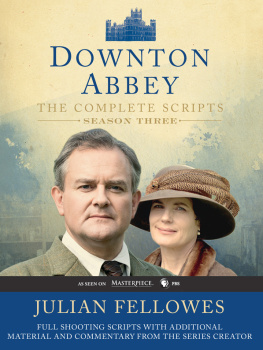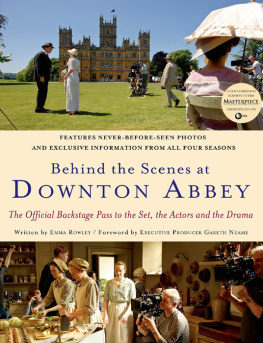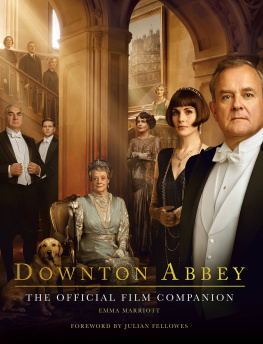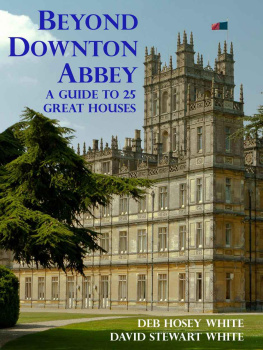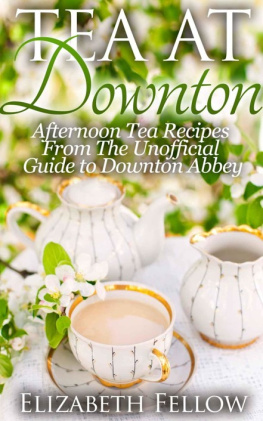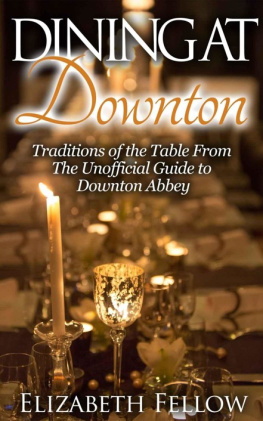Contents
Guide


Downton Abbey
THE OFFICIAL FILM COMPANION
EMMA MARRIOTT
FOREWORD BY JULIAN FELLOWES

The author and publisher have provided this e-book to you for your personal use only. You may not make this e-book publicly available in any way. Copyright infringement is against the law. If you believe the copy of this e-book you are reading infringes on the authors copyright, please notify the publisher at: http://us.macmillanusa.com/piracy.
It seems strange to write it now but when, a decade ago, Gareth Neame suggested that I might like to create the series that later became Downton Abbey, I wasnt all that enthusiastic. Some years before, I had written a film called Gosford Park, examining the lives of a group of house guests, and their servants, at a shooting party in 1932, and Gareths idea was that I should revisit the same territory, only this time for television. At first, it seemed like asking for a second slice of cake, and anyway, the underlying message of the film had been that this kind of life was coming to an end for all but a minuscule minority. But the last problem was solved by moving the starting point back by twenty years, from 1932 to 1912, and soon I found myself considering issues that interested me but had never before found an outlet in my work.
What was it like for that tidal wave of American heiresses who came to the rescue of the British aristocracy in the 1890s and 1900s after twenty or thirty years, separated as they were from the values of the New World? How would it be for a man to inherit a position and an estate when they had grown up in an entirely different way? I had a friend who arrived on these shores as the heir to a great name when he had started life in a different culture entirely. Could he make a success of it? In real life, as far as my friend was concerned, the answer was yes and he did, very much so, but how would it be for Matthew Crawley?
And so gradually, as often happens when you start to work on a new project, I was dragged into the lives of these people I had made up but came to love, until they formed the centre of my world, and to my great pleasure, it soon became apparent that they would bring a lot of enjoyment to people almost everywhere.
Being caught up in a phenomenon is hard to describe. It was unbelievable at first, but rewarding too and a real sign that, just for once, we had got it right. As it happens, I have been lucky over the years, but when I die, I am fairly certain that Downton Abbey will be the marker of my passing. Nor do I resent this. Any more than, I am sure, Matthew Wiener would mind being remembered for Mad Men or Aaron Sorkin for The West Wing. I enjoyed the initial challenge of finding an audience for the show, and the renewed thrown gauntlet at the start of every season of proving we could keep up the standard we had set. I think we did, although it sounds vain to say it. Our audiences stayed loyal until the finish, and now we have the pleasure of giving them the chance of another visit to that wonderful house (for Highclere Castle is a wonderful house) and the fun of catching up with their favourite characters. Actually, there was something almost surreal, like a kind of time travel, as we gathered together at the read-through, and then reassembled in the great hall, the cast back in costume, the crew resuming their tasks. Now it is done and we are ready to show the film to the public in the hope of their approval.
This book will allow them to share the fun of making the movie, the different stages of development, the various departments involved. It is about our return to Downton, and I hope it will have a favoured place on the shelves of those who buy it, as a lasting memento of a show that found a way into their hearts.
Julian Fellowes
June 2019

The year is 1927. Downton Abbey, the seat of Lord Grantham, is cloaked in morning mist, just before the sun breaks through and rises steadily over the Yorkshire countryside.
Inside, the servants are up and ready for the day: Mr Barrow is in his butlers livery, Mrs Patmore and Daisy are busy in the kitchen, Mrs Hughes attends to her paperwork. Upstairs, Lady Mary and Tom Branson are already in the dining room; Lord Grantham is making his way down. All is as it should be and has always been a normal day on the Downton estate.
Yet for the previous few hours, a letter has been journeying towards the house. Beginning its passage in a gilded room, it is placed inside a leather satchel and carried away by a liveried official. Mailbags are loaded on to a night train, and as it thunders through the darkness, postal workers sort letters into pigeonholes. At dawn, a van winds its way through the waking Downton village until it stops at the post office. Its a GPO motorcycle that drives up the gravelled approach to Downton Abbey and stops outside the servants entrance a sign of the changing times. Andy the footman opens the back door and the postman holds up the letter.
The letter bears the crest of the royal coat of arms, its journey having begun at Buckingham Palace. It announces the impending arrival of King George and Queen Mary, who are to visit Downton Abbey as part of their tour of Yorkshire. Almost at once the familiar rhythm of the house is altered the day, and the next few weeks, will be anything but normal.


Over a decade ago, Gareth Neame had a seed of an idea. With over twenty-five years experience working in British drama, he probably had a great many ideas in his head. This particular one, however, would lead to the creation of one of the most successful television dramas ever made, capturing millions of fans across the world, in over 250 territories, earning critical acclaim and recognition including three Golden Globes, fifteen Emmys, a BAFTA Television Special Award and four Screen Actors Guild awards.
Gareth had for a long time thought that the setting of an English country estate could provide the perfect backdrop for a television series. Some years earlier, he had seen Robert Altmans film Gosford Park and had been impressed by its compelling depiction of country-house life, both those working in the house and its guests. He discussed the idea with Julian Fellowes, who had won an Academy Award for his original screenplay for Gosford Park. Drilling into the concept further, Gareth and Julian agreed the television show should have an Edwardian setting, but with a pace of narrative and density of stories more familiar to contemporary dramas. Crucially, it should follow the lives of the family and their servants in equal measure.


